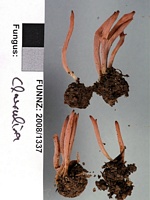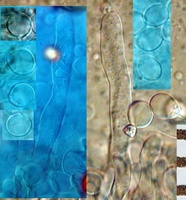|
 Clavulina vinaceocervina var. avellanea Clavulina vinaceocervina var. avellanea
BiostatusPresent in region - Indigenous. Endemic
Images (click to enlarge)
Owner: J.A. Cooper | 
Caption: cystidia and spores
Owner: J.A. Cooper |
Article: Petersen, R.H. (1988). The clavarioid fungi of New Zealand. New Zealand Department of Scientific and Industrial Research, Bulletin 236: 170 pp. Wellington:.
Description: Fruit bodies up to 6.5 x 2 cm, branched, arbuscular, with branches in 2-4 ranks, or subsimple, with club branching once or twice very near its apex. Stipe short, often imperceptibly merging with hymenium, arising from a small tangle of white mycelium, and sometimes clothed at base with minutely hispid whitish mycelium, flattened or lobed in cross section, pale to light yellow ("light ochraceous buff" to "warm buff"), becoming concolourous with branches. Branches flattened somewhat, often covered with white powder (spores), minutely hispid (from cystidia), pale to light buffy yellow ("pale pinkish cinnamon", "light ochraceous buff") when young, becoming fleshy brown to violaceous tan ("light pinkish cinnamon", "fawn color", "wood-brown", "vinaceous brown", "cacao-brown", to "avellaneous"); axils narrowly rounded; internodes very irregular, diminishing irregularly. Apices awl-shaped, rarely subcristate, short to long, concolourous to branches, turning black in age, especially when dry. Bruises or abrasions slowly turning chocolate-brown ("walnut-brown").
Tramal hyphae of upper club or branches 2.5-7 p m diam., without clamp connections, hyaline, thin- to slightly thick-walled (wall up to 0.2 gm thick), generally but loosely parallel. Hymenium thickening considerably; basidia 65-75 x 7-9 gm, narrowly clavate, without clamp connection, at maturity multiguttulate, the guttules refringent; post-partal septation common but not invariable; sterigmata 2, curved-divergent. Cystidia (Fig. 65) cylindrical, 85-160 x 10-12 gm, slightly thick-walled (wall up to 0.5 gm thick), rounded at apex, without clamp connection; apical portion often refringent, especially in younger hymenia; median band of roughened wall or crystalline deposit within hymenium (not above it).
Spores (Fig. 66) 7.6-11.2 x 7.9-10.4 gm (E =1.00-1.32; El =1.12; L'° = 9.8 gm), globose to very broadly ovate, hyaline, white in prints; contents with one large
guttule, or often with major guttule and several smaller peripheral guttules; hilar appendix papillate.
Habitat: Under both mixed podocarp and Nothofagus forest.
Notes: Two collections below (TENN no. 43398, 43399) were made side by side, but were kept separate for two reasons: (i) they were perceived as belonging to separate mycelia, for they were separated by several metres; and (ii) the fruit bodies of one (no. 43399) were generously branched whereas those of the other were linear, subsimple, and branched only at the apex or monopodially. Under x60 the hymenium of both were obviously setulose, covered with a turf of protruding cystidia,'which trapped spores to form a fine white powder. Fruit bodies of both collections dried to a sordid olivaceous grey. When both were found to be identical microscopically, their conspecificity was confirmed. McNabb no. 31 and 108 (PDD) reflect precisely the same macroscopic differences, with the simpler fruit bodies bearing obvious chocolate-brown bruises. I am tempted to propose forms based on habit, but insufficient collections have been examined to make this practical.
It is possible that these collections belong in the typical variety of Clavulina vinaceo-cervina, but I have had experience with that taxon (Petersen 1983a) and consider them not to be contaxic. The typical variety shows pinkish to rosy colours, not dull violaceous brown, and bruises turn vinaceous, not chocolate¬brown. Cystidia and spores, conversely, are similar, and both fungi lack clamp connections. I conclude that if some red pigment was removed from fruit bodies of C. vinaceo-cervina, and its pigments, therefore, "flattened" toward neutral browns and/or yellows, it would be easy to derive a colour-form like var. avellanea. This is the reason for my disposition of the collections.
Corner (1970) has reported encrusted cystidia in the hymenium of various Clavulina taxa. I have never seen these, although I have mounted hymenia in both 2% KOH and in water. Conversely, I have observed wall irregularity and/or very fine crystal deposits, as described here. I do not know under what conditions incrustation might be visible. Cystidia in this taxon usually arise lower in the subhymenium then basidia, and wall irregularity of cystidia in var. avellanea is rare, and occurs 20-30 gm lower than the surface of the hymenial layer.
|